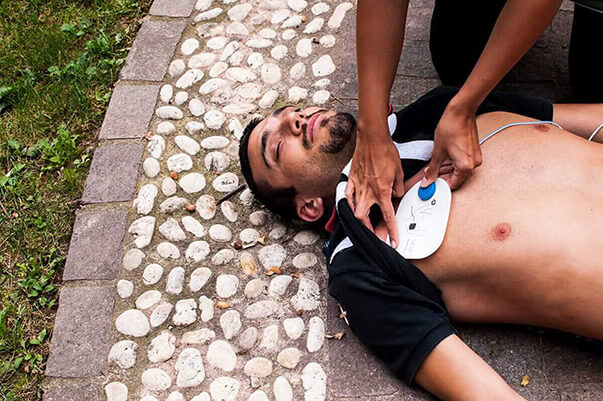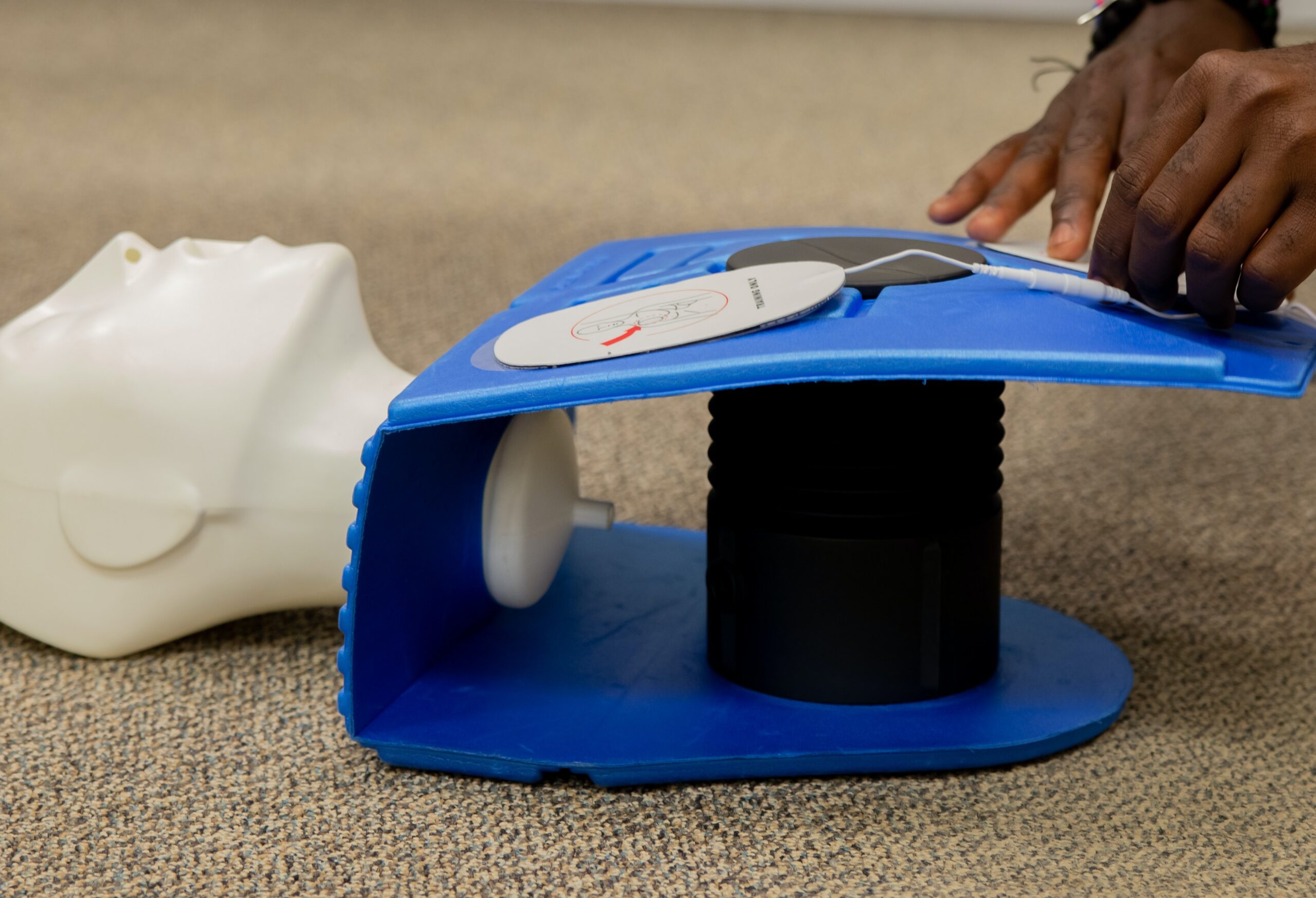The Importance of BLS for Police Officers: How it Can Save Lives?
13/11/2024

April 05, 2021
What is the importance of AED training? AED stands for automated external defibrillators. Easy and safe device to use, AED delivers a therapeutic electric shock to the heart to the victim in Sudden Cardiac Arrest (SCA). More than 350,000 people experience sudden cardiac arrest (SCA) outside of the hospital every year in the United States. Additionally, SCA is one of the leading causes of death, and of the 350,000 cases, 90% prove fatal.
Why is an AED needed? Using an AED on an SCA victim can double or triple the chances of survival for these victims. Why, then, do we only have about 10 percent of the total required AEDs for SCA cases? Part of the reason for this shortage is that people don’t know how to answer the question, what is an AED used for?
This blog uncovers the correct usage for AEDs and discusses how they can save numerous lives every year. It also covers the benefits of First Aid CPR AED training and AED guidelines and use.
If you find yourself in an emergency or encounter a person in cardiac arrest situation, there’s little time to sit and decide your next steps.
You have to react. Correct crisis response comes from having the necessary experience and knowledge you get from training.
Before the heart stops beating, you must help the patient with chest compressions and call the medical emergency team. However, the action to perform CPR has to be fast with AED when the patient is not breathing, and you cannot hear them respond to your commands or requests to wake up.
You might think that you can just contact medical authorities and wash your hands clean of the situation. However, medical responders often don’t arrive on the scene until 8-12 minutes after an emergency call.
Brain damage or death can occur within minutes of a cardiac arrest emergency. That means you don’t have time to sit and wait for medical responders to arrive. For each minute victims don’t receive CPR AED attention, their odds of survival decrease 10%.
For these reasons, having access to and understanding how to safely use an AED can literally be the difference between life and death. But what do AEDs do? And how do they help people in cardiac arrest? Let’s read about the importance of AED in this blog.
With an AED device, you can deliver an electric shock to the person who is on the verge of dying. You need to save their life as a good citizen and human being. Now, this patient could be anyone. They might be a stranger or someone you know. It could happen to literally anyone in the world. However, if you act on time, using AED devices, it can really make a difference.
Sudden cardiac arrest (SCA) occurs when an electrical disruption between your brain and heart causes loss of heart function, breathing, and consciousness. This interruption stops blood from reaching your brain.
Cardiac arrest usually occurs from ventricular fibrillation, a spasming of the heart. It’s important to note that cardiac arrest is not the same as a heart attack. However, heart attacks can sometimes trigger the electrical disturbance that causes cardiac arrest.
If the victim does not receive treatment immediately, it can lead to a sudden cardiac death. Survival is only possible with fast, correct medical attention. CPR and using an AED are the most simple and accessible forms of treatment.
AEDs, or automatic external defibrillators, immediately analyze the victim’s cardiac arrhythmia. Two primary arrhythmias cause cardiac arrest- ventricular tachycardia (V-Tach) and ventricular fibrillation (V-Fib). Both arrhythmias cause the heart to beat erratically, preventing it from pumping blood to the brain and extremities.
When an AED detects an irregular heart rhythm, it administers a shock to restart the heart. If it doesn’t notice an abnormal rhythm, it won’t issue a shock.
After identifying a shockable heart rhythm, the AED charges its capacitors and delivers a shock between 150 to 360 joules. This shock is strong enough to depolarize the heart muscle and reset its natural pacemaker, causing it to beat naturally once more.

If you find yourself in a cardiac arrest emergency, the first step you should take for adults is to call 911. Then, if there is a bystander with you, you should direct them to find an AED while you begin administering hands only CPR.
If you are the only one on-scene, start administering chest compressions immediately. When medical responders arrive, they will have an AED and be able to issue a shock. In the meantime, you must keep the victim’s blood flowing.
If you are at the scene of a cardiac arrest emergency and someone else can perform CPR while you locate an AED, the following steps can help you.
Though using an AED may seem straightforward, you should consider getting certified. In high-pressure situations, it can be challenging to remember all the necessary steps. Getting certified can turn these steps into second nature, so you act in these emergencies instead of think.
You may be reluctant to get your CPR AED certification because you have a busy schedule and don’t have the time to commit to in-person training. That’s not a problem. With online training courses, you have the opportunity to control your learning pace and get certified when it’s most convenient for you.
Blended courses offer an excellent alternative to in-person classes as well. These classes give you hands-on training from the comfort of your home. American Health Care Academy courses use CPR/AED experts and offer affordable solutions that get you instant certification.
These classes will help you feel confident in your life-saving abilities so that if you find yourself in a cardiac arrest emergency, you can respond quickly and decisively.
Public spaces and offices have gotten a lot better about having at least one AED available on the premises. However, a significant number of SCAs occur at home, identifying the glaring need for families to carry one in their house.
Having an AED in your house can help provide immediate medical attention if a loved one experiences an SCA. If a victim does not receive defibrillation within five minutes, their chances of survival can decrease by over 50%. Their chance for survival decreases 7% each minute after that.
The goal for homes, offices, and public spaces should be to have an AED no more than 90 seconds away from cardiac arrest victims. Having an AED within 90 seconds can increase the victim’s chances for survival by 500% compared to waiting for EMS to arrive.
CPR and AED guidelines originate from an array of international organizations. Bi-annual conferences review research and determine the best protocols to increase SCA survival rates.
These protocols update every five years and they address new teaching materials and techniques for rescuers.
If you find yourself in a cardiac arrest emergency, will you have the knowledge and experience to act? Will you know how to deliver life-saving assistance? Don’t question your abilities. Get your CPR/AED certification and answer the question, “what is an AED used for?”
American Health Care Academy offers affordable online CPR training online and recertification so you can feel confident in emergencies.
Even if you are already certified, studies show that CPR and AED skills can diminish within six months of certification.
We can help keep your skills sharp and turn you into a leader in your community. Register today to discover the many benefits of getting CPR/AED certified and learn how to save lives no matter where you are.